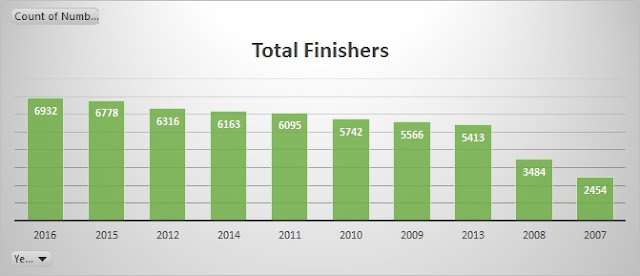The Numbers
It'll be no surprise to learn that the number of entrants to the Half Marathon have grown steadily over the years. So too have the number of finishers, as displayed below. Actually when you look at 2015 and 2016, it would seem that popularity has increased even further:
Finishing Times
Are we getting slower? Probably not, although the average finishing time (based on chip timing) is a lot longer than 2007, this is most likely down to the fact that the 2,454 finishers in 2007 were probably closer to elite runners (running wasn't as popular). Whereas the increase in numbers up to this year has probably added more "casual runners" (like myself), hence the average times increase, see below:
Running Groups / Clubs - do they help?
This is not an exact science, but I thought it would be interesting to take a look at the performance of people who run in a club or running group against those that do not. There is a natural expectation that the average times of those in running clubs would be faster, because most, if not all, the elites will be members of clubs. At the same time, this balances out, as some of the running groups are targeted at first time runners looking to finish, rather than chasing a time.
- 2016
- Average Time of non-affiliated runners: 02:00:11
- Average Time of affiliated runners: 01:55:35
- 2015
- Average Time of non-affiliated runners: 01:58:24
- Average Time of affiliated runners: 01:53:25
In both years the runners associated with clubs or groups are on average 5 minutes faster than those that are not.
Male versus Female Runners
The increase in the number of finishers over the past 10 years has been heavily driven by more women entering the race. In 2007, 32% of the total finishers were women (just under 800). In 2016, 41% of the total finishers were women (just under 2,900).
Finishers from Groups and Clubs
Finally, for a bit of fun, here's the list of the running groups and clubs with the most amount of finishers this year. I'm not going to compare times here, because really that would be done as a team event, so a bit unfair to retrospectively do it. Here are the top participant clubs/groups:
Top 10 Athletics Clubs
Top 3 Running Groups






No comments:
Post a Comment